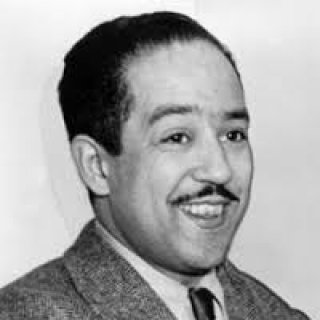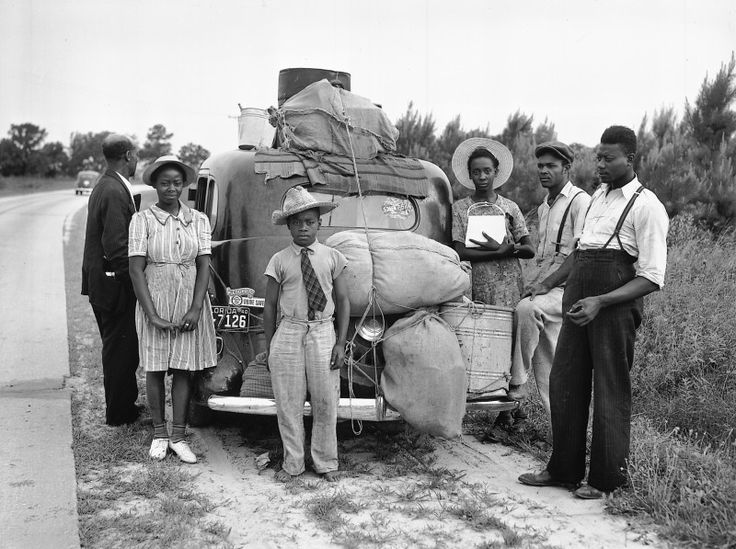Review
Jacob Lawrence's Migration Series Successfully Fails to Capture Motion
by Thomas Rodrigues
One Way Ticket
I pick up my life,
And take it with me,
And I put it down in
Chicago, Detroit,
Buffalo, Scranton,
Any place that is
North and East,
And not Dixie.
And take it with me,
And I put it down in
Chicago, Detroit,
Buffalo, Scranton,
Any place that is
North and East,
And not Dixie.
I pick up my life,
And take it on the train,
To Los Angeles, Bakersfield,
Seattle, Oakland, Salt Lake,
Any place that is
North and West,
And not South.
And take it on the train,
To Los Angeles, Bakersfield,
Seattle, Oakland, Salt Lake,
Any place that is
North and West,
And not South.
I am fed up
With Jim Crow laws,
People who are cruel
And afraid,
Who lynch and run,
Who are scared of me
And me of them
With Jim Crow laws,
People who are cruel
And afraid,
Who lynch and run,
Who are scared of me
And me of them
I pick up my life
And take it away
On a one-way ticket
Gone up North
Gone out West
Gone!
And take it away
On a one-way ticket
Gone up North
Gone out West
Gone!

Langston Hughes
Of all peoples, we might venture that the one-way ticket is most suited to children of diaspora. It is a voucher which carries with it a certain amount of momentum, a certain sense of absolute departure, a certain radical homelessness. French-Algerian writer Hélène Cixous has professed that in navigating her intricate, (de)colonialized identities as an adolescent, she felt "perfectly at home, nowhere" (My Algeriance, 208). Alienating as this was, in retrospect Cixous understands it as a liberatory moment, as a moment of freedom. "[A]n inconvenient, intolerable freedom," yes, but also, "a freedom that obliges one to let go, to rise above, to beat one's wings." (My Algeriance, 208). Such an image, such an invocation of avian freedom, exemplifies the spirit of Jacob Lawrence's Migration Series, currently on display at New York City's Museum of Modern Art (11 West 53rd Street, New York, NY 10019). For, in a (post-)globalized world, in a world where xenophobia often truncates mass human movements, the possibility of a liberatory "migration" has been left, at least in the West (a term which is, of course, itself problematically exclusionary), for the birds. But this has not always been so, and in Lawrence's series of sixty vibrant tempera paintings, we witness the complex, frequently self-conflicting power of the migratory.
Borrowing its name from Langston Hughes' poem, MoMA's exhibit, "One-Way Ticket: Jacob Lawrence's Migration Series and Other Works," offers a glimpse of the (admittedly fraught) freedom experienced as a consequence of feeling "perfectly at home, nowhere." Indeed, Lawrence's first panel depicts a faceless mass of African-Americans funneling through three gateways at an unspecified Southern train station. The crowd appears to choose indiscriminately among the three portals – Chicago, New York, St. Louis; the destination matters not. "Any place that is North and East, And not Dixie," as Hughes wrote. "Any place that is North and West, And not South."
Yet, beyond Hughes, in Lawrence, facelessness is as important as placelessness. As one moves through Lawrence's panels, one is struck by the painter's insistence on anonymity. With, at most, a handful of exceptions, the faces of Lawrence's African-American adults are either left entirely blank or rendered with one or two brushstrokes so broad that they resist any identification beyond simply, "face." Such facelessness, though, does not afflict Lawrence's white figures. In various paintings we see a white industrial laborer with eyes, nose, mouth, dimples, defined jawline (Panel 2); two white policemen, nightsticks in hand, with simple faces, but among a crowd of faceless African-American migrants (Panel 12); a white judge, expressively examining legal documents before – again, faceless – two African-Americans (Panel 14); two white diners in a Northern restaurant, cordoned off from several anonymous African-American diners (Panel 49); a white, red-headed man attacking a faceless African-American in the midst of a Northern race riot (Panel 50). Throughout the Migration Series, the Anglo-American has a face; the African-American does not.
Is it possible that this is meant to indicate the downside of the one-way ticket, the erasure which, perhaps inevitably, accompanies diaspora? We have been referring to Lawrence's black figures as "African-American," but even this "politically correct" designation manifests the plight which haunts Lawrence's subjects. The men, women, and children who populate the Migration Series were Southern blacks who participated in the Great Migration (the first wave of which spanned, roughly, 1910-1930), meaning they were almost exclusively the progeny of slaves. And yet, abducted from Africa though they were, most of them were not, in any traditional sense, "African." Nor, though – during the Great Migration, in 1941, when Lawrence crafted his Migration Series, or perhaps even, given Ferguson, given Staten Island, given Baltimore, now – were they really "American." Not fully African, nor fully American, but existing in-between. Existing not as hyphenated, but as hyphen.
Not fully African, nor fully American, but existing in-between. Existing not as hyphenated, but as hyphen.
Cixous, a member of a different diaspora, one of many "living fragment[s]" of her family that remained "after it blew up on the Nazi minefield" (My Algeriance, 204), expressed a similar sense of existence when she professed, "It is this verb to be that has always bothered me. What are you? Are you French? Who am I? Am I her? And to answer with a word or a cross in the box, when I would need one hundred or a blank" (My Algeriance, 206). The child of diaspora, of any diaspora, inhabits an identity at once immeasurably complex – demanding one hundred words – and fundamentally vacated – blank, voided, "–." Note, though, that the latter does not mean such people are entirely without identity, but rather that they possess a certain ungrounded identity, an identity which exists in interstices, or which floats above the void, which is to say, a postmodern identity pushed to its limit (is the diasporic subject the postmodern subject par excellence?).
It would seem, then, that Lawrence's black (to continue calling them "African-American" at this juncture seems rather disingenuous, yet indicating them with merely "–" seems rather pedantic and prone to untoward misinterpretations) figures could not possibly have been bestowed with precise facial features, at least not if Lawrence was to be faithful to his subject. To preserve a face in paint is to endow its possessor with a certain permanence, with a concrete, stabilized, identity. Beyond the canvas, though, it is privilege, wealth, power, whiteness, maleness, straightness, surname, through which permanent, concrete, stabilized identities are secured. Only those who luck into these accidents are free from the burdens of constantly having to assert their identities.
Thus, as a reflection of such a reality – a reality surely even more apparent when Lawrence was working in 1941 – only Lawrence's white figures are gifted with faces, with indicators of their undisputed – and undisputable – identities, and necessarily so. For the identities of his black figures, the identities of his diasporic subjects, are impossible to hold stationary. They are always in motion, always in flight, always ready to proclaim alongside Hughes, "I pick up my life, And take it away, On a one-way ticket." A ticket to where, as has been said, it does not matter. Cixous, yet again, aligns with Lawrence by explaining, "I have always rejoiced at having been spared all 'arrival.' I want arrivance, movement, unfinishing in my life…The desire, the necessity of arriving 'home,' I understand them and do not share them. What loss! What renunciation of the marvelous and infinite human condition" (My Algeriance, 227). If nothing else, by omitting the details of his black faces, Lawrence managed to honor the arrivance of the brave souls who constituted the Great Migration, their movement, their unfinishing, their marvelous and infinite human condition.
Panel 6
Panel 7
Perhaps most exemplary of this are Lawrence's Panel 6 and Panel 7 (see above), specifically the interplay and transition between them. Panel 6 depicts an overcrowded train car, most of its occupants sleeping, one woman breastfeeding her infant, who, presumably, will sleep in its mother‟s suitcase which sits flung open in the aisle. Most of the (all black) figures' heads just barely creep above their covers, preserving an exceptional – even for Lawrence – sense of anonymity among them. Panel 6 is an image of a population in transition, in motion, and, apropos of such a subject, the image itself seems to flow into its successor. The content of Panel 7, though, is less clear. It is, especially within the context of the Migration Series, an unusually abstract collection of shapes, the colors of which seem to be borrowed from the previous panel. Panel 7 looks almost as if one attempted to photograph the train car from Panel 6 as it sped away. The colors have bled together; the figures intermixed to the point of indistinguishability; the migrants and the migration become one. Indeed, Lawrence's original 1941 caption for Panel 7 seems to sanction such an interpretation: "The Negro, who had been part of the soil for many years, was now going into and living a new life in urban centers."
We might, then, approach Panel 7 as a portrait of migration as such. The orientation of its colorful shapes, arranged in such a way that their milieu‟s vanishing point is clearly somewhere beyond the top of the panel, suggests upward motion. A great upward migration, "Gone up North, Gone out West, Gone!" It is this closing stanza of Langston Hughes' "One Way Ticket" that Jacob Lawrence managed to write in tempera as only a true master can. Such a translation, it should go without saying, is an unmissable sight.

Southern African-American family traveling north, circa 1915
"One-Way Ticket: Jacob Lawrence's Migration Series and Other Works" runs through September 7, 2015, at the Museum of Modern Art (11 West 53rd Street, New York, NY 10019).
Referenced Works:
Cixous, Hélène. "My Algeriance, in Other Words: To Depart Not to Arrive from Algeria." Translated by Eric Prenowitz. Stigmata. New York: Routledge, 2005. Print.
Cixous, Hélène. "My Algeriance, in Other Words: To Depart Not to Arrive from Algeria." Translated by Eric Prenowitz. Stigmata. New York: Routledge, 2005. Print.